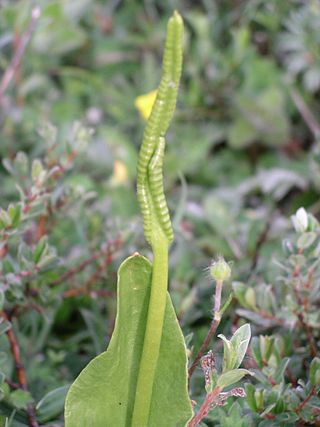Top Qs
Timeline
Chat
Perspective
Ophioglossum
Genus of fern in the family Ophioglossaceae From Wikipedia, the free encyclopedia
Remove ads
Ophioglossum, the adder's-tongue ferns, is a genus of about 50 species of ferns in the family Ophioglossaceae. The genus name comes from Ancient Greek ὄφις (óphis), meaning "snake", and γλῶσσα (glôssa), meaning "tongue".[3] Their cosmopolitan distribution is mainly in tropical and subtropical habitats.[3]
The genus has the largest number of chromosomes in the known plant kingdom, but contrary to popular belief does not have the largest number of chromosomes out of all known organisms, falling short to the protist Sterkiella histriomuscorum.
Remove ads
Description
Adders-tongues are so-called because the spore-bearing stalk is thought to resemble a snake's tongue. Each plant typically sends up a small, undivided leaf blade with netted venation, and the spore stalk forks from the leaf stalk, terminating in sporangia which are partially concealed within a structure with slit sides.[3]
When the leaf blade is present, there is not always a spore stalk present, and the plants do not always send up a leaf, sometimes going for a year to a period of years living only under the soil, nourished by association with soil fungi.
The plant grows from a central, budding, fleshy structure with fleshy, radiating roots.
Ophioglossum malviae is known as the world's smallest terrestrial fern.[4]
Remove ads
Taxonomy
Ophioglossum has a high chromosome count in comparison to other species, with 120 or up to 720 chromosomes possible in intervals of 120 due to polyploidy (multiple possible copies of chromosomes). It has almost 1260 number of chromosomes in the meiocyte (spore mother cell) which undergo meiosis, the reduction division to form the spore with only one set of chromosomes getting incorporated into each spore.[5] The species Ophioglossum reticulatum has the highest number of chromosomes found in any multicellular organism.[6]
Remove ads
Taxonomy
The Smith et al. classification of 2006, based on molecular phylogeny, placed Ophioglossum in Ophioglossaceae.[7] Subsequent classifications have maintained this placement.[8][9][10] Circumscriptions of the genus vary. The Christenhusz and Chase classification of 2014 includes Cheiroglossa and Ophioderma within Ophioglossum.[9] This circumscription corresponds to subfamily Ophioglossoideae in the PPG I classification, which recognizes Cheiroglossa, Ophioderma, and Rhizoglossum as separate genera.[10] More recently, it has been proposed to subdivide Ophioglossum more narrowly, removing a number of species into the new genera Goswamia, Haukia, and Whittieria.
Phylogeny
Summarize
Perspective
Phylogeny of Ophioglossum[11][12]
| Ophioglossum |
| |||||||||||||||||||||||||||||||||||||||||||||||||||||||||||||||||||||||||||||||||||||||||||||||||||||||||||||||||||||||||||||||||||||||||||||||||||||||||||||||
| s.l. |
Unassigned species:[2]
- (Goswamia)
- Ophioglossum gujaratensis S.M.Patil et al.
- Ophioglossum hitkishorei M.Patel & M.N.Reddy
- Ophioglossum indicum B.L.Yadav & H.K.Goswami
- Ophioglossum isanensis Petchsri, Li Bing Zhang & Jaruwatt.
- Ophioglossum malviae M.Patel & M.N.Reddy
- Ophioglossum raphaelianum Anto et al.
- (Haukia)
- Ophioglossum opacum R.Br.
- Ophioglossum tuberosum Hook. & Arn.
- (Ophioglossum) s.s.
- Ophioglossum ammophilum C.D.Adams – sometimes included in O. gomezianum
- Ophioglossum azoricum C.Presl
- Ophioglossum caroticaule J.E.Burrows
- Ophioglossum convexum J.E.Burrows
- †Ophioglossum eocenum (Massalongo) Schimper
- Ophioglossum fernandezianum C.Chr. – doubtful species
- Ophioglossum × giovanninii Peruzzi, Pierini, Magrini, Marchetti & Viane
- Ophioglossum gracile J.E.Burrows ex Pocock – may be included in O. gramineum
- Ophioglossum gracillimum Welw. ex Hook. & Baker
- †Ophioglossum granulatum Heer
- Ophioglossum harrisii Underw.
- Ophioglossum jaykrishnae S.M.Patil, S.K.Patel, Raole & K.S.Rajput – provisionally accepted name
- Ophioglossum latifolium (Prantl) J.E.Burrows
- Ophioglossum lineare Schltr. & Brause – possibly a synonym of O. parvifolium
- Ophioglossum louisii Taton
- Ophioglossum loureirianum Presl
- Ophioglossum melipillense J.Rémy
- Ophioglossum oblongum H.G.Zhou & H.Li
- †Ophioglossum ornatum Faddeeva
- Ophioglossum × pierinii Peruzzi, Magrini, Marchetti & Viane
- Ophioglossum × pseudoazoricum Peruzzi, Pierini, Magrini, Marchetti & Viane
- Ophioglossum richardsiae Burrows
- †Ophioglossum senomanicum Chlonova
- Ophioglossum sandieae J.E.Burrows
- Ophioglossum scariosum Clausen
- Ophioglossum thomasii Clausen
- Ophioglossum yongrenense Ching ex Z.R.He & W.M.Chu
Species that may be placed in this genus include:[2]
- Ophioglossum falcatum (Presl) Fowler = Ophioderma falcatum
- Ophioglossum intermedium Hook. = Ophioderma intermedium
- Ophioglossum simplex Ridley = Ophioderma simplex
Remove ads
References
External links
Wikiwand - on
Seamless Wikipedia browsing. On steroids.
Remove ads

